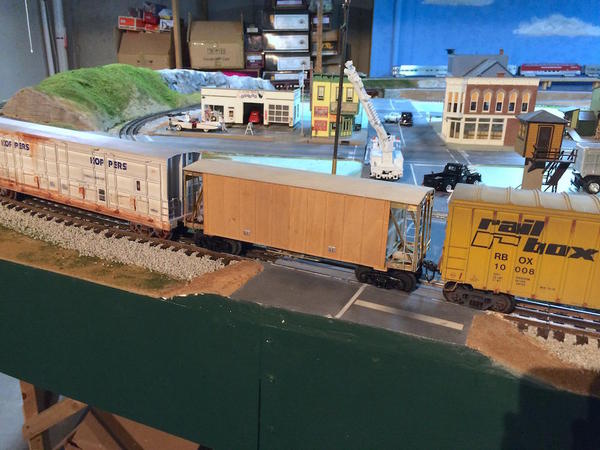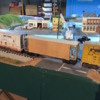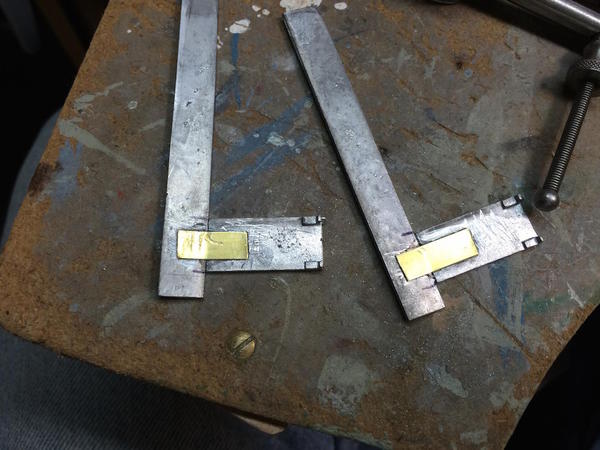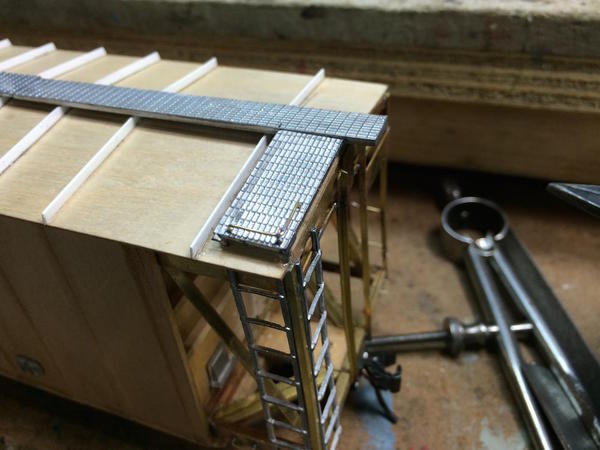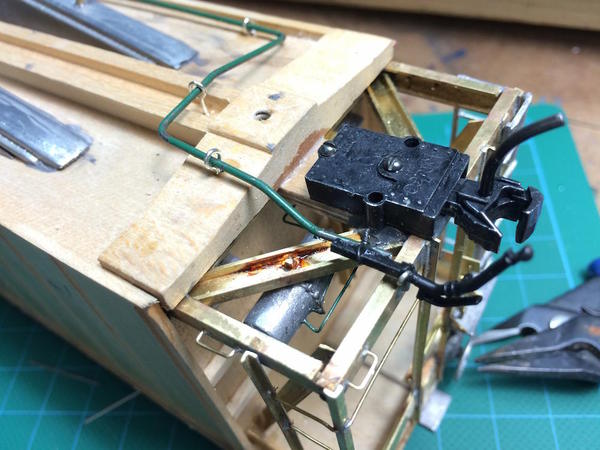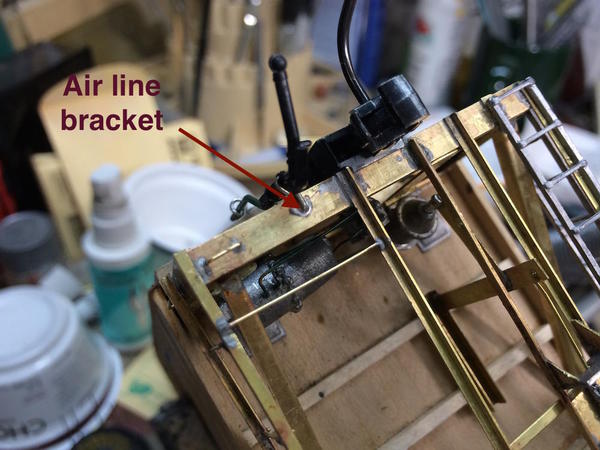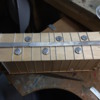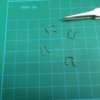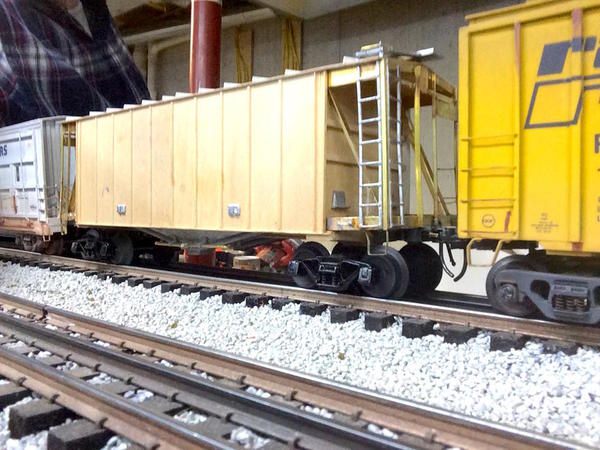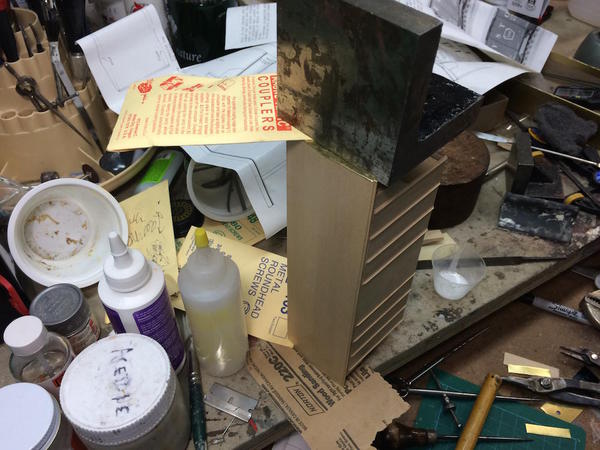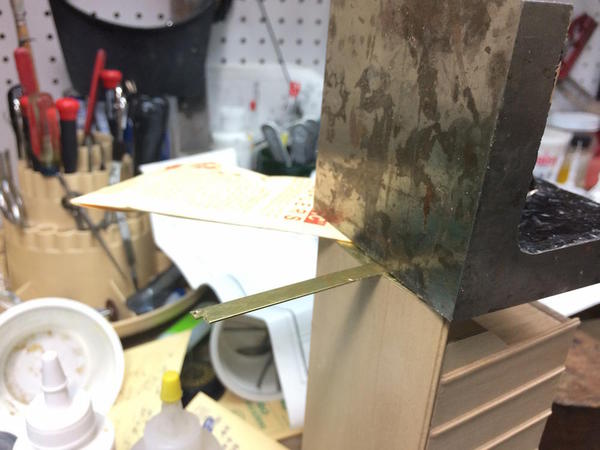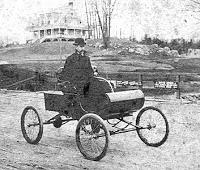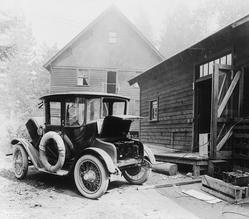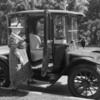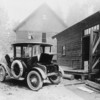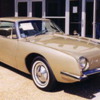That was a miracle about the wheel that it wasn't damaged. The funniest things can happen.
Yes! Quite miraculous.
Work progressed... I searched out some pictures of Airslide hoppers to look at the mechanism around the discharge chutes. It turns out that the details on the model are very simplistic. It's actually a fairly robust pipe which is where the air goes in thus the name "airslide" hopper. I used 1/16" brass rod with an enlargement solder on along with a small True Details bolt casting.
In the pic I notice that my brackets weren't the same length. DOH!
I then figured that I'd better prepare the mounting for the trucks and the couplers since it required the model to be upside down that the roof detail will be delicate. This is consistent with the strategy to do everything first and the roof last. I'm using a self-taping sheet metal screw that's almost the perfect size to hold on Atlas trucks. The screw head needs to be turned down about 0.030" so it just slips inside the truck mounting hole.
I also had to grind about 5 threads off the length AFTER I pre-threaded the screws into the holes drilled in the truck bolster. Speaking of drilling. Wouldn't you know it... the center of the bolster lies directly below the middle of the car body end wall. The drill opened up the wall with a crescent shaped hole, which I then needed to fill.
I'll finish that up tomorrow after the spackle dries.
I had to build up the Kadee couplers. One of the knuckle springs was separate and I had to install that very small spring. My first attempt went "Boing". I was able to find it after sweeping the floor. The next time I remembered a useful trick. Put a piece of thread through the spring, hold onto the thread while messing around with the tweezers. Worked like a charm! After the spring's in, pull out the thread.
I followed instructions posted by one of our readers in that I used my automatic center punch to swage the screw holes a bit to lock the lid onto the assembled Kadee coupler. It keeps it from falling apart while attaching it to the model. Then I put the trucks back on after removing the 3-rail couplers. Had to see how it looked lashed up with the other two kit-built cars in my inventory.
Coupler height is perfect.
Lastly I installed the roof ribs. Instead of using the very old wood strips, I substituted styrene. You make a small v-shaped notch in the middle to help the strips conform to the roof pitch. This is held on with CA. Ends are trimmed with the Xuron flush-cutters and the tops get sanded flat to accommodate the roof walks which will go on next session.
Attachments
Boy! You miss posting a couple of days and you're already on page 2...
I did work on Friday and did some work today. Except for the stirrups, the car is done and ready for paint. I'm thinking, I'm going to put it aside and start something else until Spring when I can do the prime painting outside.
After finishing up the roof ribs, I installed the roof walks. Before glueing them in they first had to be cut to length. Of the three pieces the end two had to be shortened about 1/4" each. Then I had to put the side walks on before gluing it down. The model had this as a white-metal, butt joint which was totally impractical. I made a couple of brass supports for underneath and the whole deal was CA'd together. Then it was time to glue it all down.
There's a 90° grab iron in the corners that needed making. I bent this out of .020" brass and used a small model ship parts i-bolt in the middle. I soldered this eyebolt in its position with the RSU. I drilled some holes in a wood block to hold everything still while soldering.
Then I drilled the holes in the walks, inserted and then CA'd the grabs into position.
With the roof walks done, I could measure and install the loading hatches. These are held in place with medium viscosity CA. The top is now complete.
Some more work is needed underneath. I had to add the train line air line and the corner stirrups. I routed the airline based on the model's drawing. I used some left over eye bolts from the Brennan chain link fence project. I also wanted to add the simulated glad hands the I removed from the large O'gauge Atlas couplers on these freight trucks.
Eyebolts were held in with CA.
In addition to CA, I used some twisted black iron wire to reinforce the plastic to steel-wire glue joint. I also made one more eyebolt to secure the air line end to the end beam. This was soldered in with the RSU.
I'm now sure that the airline end will hold up in operational use. I tried the trucks back on and sure enough, they impinged on the eyebolts sticking up on the bolster. I mashed one end's down so it cleared, and repositioned the other and went to a U-bolt arrangement. I also sawed off the remaining lug on the truck that attached the original coupler.
Here's the last parts to be made that will go on in the next session. I produced them out photo-etch-fret brass. I'm going to solder these on since they going onto a piece of brass channel. That's another advantage of using brass over the kit's basswood. Gluing brass to basswood produces sub-par results.
Attachments
In the last issue of OST mag I wrote an article how to make air hose and cock valves.
Nice job.
Andre.
Great work Ray.
Alan Graziano
Andre, I re-read the glad-hand article. I may (or may not) attempt that on some of my car kits. I'm also actually thinking about getting some protocraft scale couplers. I'm impressed that you could drill a #75 hole in the apex of a curved surface. I usually like to put a flat where the drill's going to go so it doesn't wander too badly.
Incidentally, it was interesting to read the editorial in the OST issue that arrived yesterday. He was speaking directly to the article series on my substation that they decided to not accept as a result of being a forum contributor. I still think they're missing the boat. I'm not at liberty to discuss further, but time will show that their policy needs to be updated.
Trainman,
I drill on a "V" cut made in acrylic.
still little tricky but possible.
Andre.
That's a good idea since my commercial V-blocks simply have V's that too big for miniature work.
I didn't seem to post these pictures. I went directly to Diecast Directs showroom since it's all of 41 miles from my house outside of Frankfort, KY. It's a really nice place with tons of things to choose from. I was like a kid in a candy store and bought the electrical service trucks, a nice little 50s Ford pickup with some street repair accessories, and asked and received a 1959, Olds 98 2-coupe which was very similar to the first car that I owned. I purchased my 59 Olds in 1965 while attending Michigan State. I drove it for two years before getting my Ford Fairlane GTA, but that's another story.
'
The Olds model was beautiful, with separately applied photo-etched stainless trim. The finish was flawless and it wasn't cheap ($65). It had a nice plastic show case.
Anyway, I took the tape off the showcase cover upstairs to admire the car. Then I took all of them downstairs. When I went to pick up the Olds' case, I inadvertently grabbed it by the now-loose lid of the showcase, and the bottom dropped out with the car, did a 180 in mid-air and landed car-side-down on the concrete. The splat was horrible! The car almost disintegrated. It is not die-cast. It was resin! The frame fractured in half, the body fractured in two large pieces. The roof fractured, and the back window popped out. Trim came un-done all over. The steering wheel came off. I was heart-broken.
The picture was taken AFTER I had glued the chassis back together. I didn't think it was possible to put this humpty-dumpty back together again. But I persisted.
Here it is reassembled.
At a distance the car looks acceptable. Close up it's a wreck. The perfect finish is perfect no more. CA got loose and got onto the finish. The stainless trim is very hard to get back in place once its been disturbed. My car was black with a white convertible top. Here's me in my one and only successful drag racing experience with the car. I won a trophy... I was the only person in my class so all I had to do was get down the strip without blowing my engine. I believe the pic was taken in the Summer of '66.

There's a silver lining. I bought the cars with the American Express Card. They have a product protection plan. If a product bought with the card is lost or damaged within 30 days of the purchase, they refund the purchase price. I contacted them, filled out the form and the money was back in my account in 24 hours.
So the car is sitting nicely in the station parking lot. It looks good as long as you don't look to close. As much as I would have wanted it to be pristine, at least I'm not out the $65 dollars. Kudos to American Express.
The Airslide car is finished except for paint and decals. Since I don't have a spray booth, I'm going to wait until Spring to spray the primer outside. I'm thinking seriously of getting a spray booth that can be vented outside.
I mounted the corner stirrups by using the RSU and soldering them in place. I then installed the trucks and put it on the railroad. Even unpainted it looks good in the train.
There's actually one little detail that needs to be added. There are two angle braces under the roof walk overhang on each end that needs to be installed. The brass construction experiment was successful and I'm going to do the same thing on the other hopper car kits that I have.
I'm now noodling what to do next. I may build another car, work on the Les Lewis fire house, or start on the mountain construction. I still have a lot of design work to do on the distillery and am waiting from Marty to get back to me on the laser-cutting test. I need laser cutting on both the distillery and the engine house projects. I'm also starting to design a coal mine, and have laid out some more spur trackage that will serve the distillery and the coal mine. The distillery will need a short spur into town. The coal mine will need a spur near the mountain. The spurs will require 3 additional Ross switches; a #4, #11 and O-80, plus about 4 pieces of O-88 curved track. I still have enough straights and roadbed left over the initial construction.
I did a size test to determine what size tunnel portal I'll need to have the tunnel entrances on curves. I used the Allegheny as a my test case since it has the widest overhang. It has to be at least 5" wide and high. The Scenic Express Pennsylvania Cut Stone Portal is wide enough and is 6.5" high at the top of the curve. It should work. None of their other styles were high enough. I'm going to use wing walls as well. If I get them soon, it will be the mountain that will be built. Grandkids and spouse have all said that it's time to start filling in the right side of the layout.
Attachments
I put those roof walk braces on. Of course it took longer than I expected. I had to solder the lower end to the brass, then CA'd the upper end under the roof walks. Done. I attempted to put more filler into that gap made by the drill for the truck screw. Of course that turned out to be a mess... broke off a ladder and then knocked off one the big diagonal braces inside the end framing. I soldered the lower end of these braces on one end of the car, but the other end I CA'd both ends (that was the end I did first). So I had to scrape all the CA off and then solder it. Finally, I glued the ladder back on.
So what to do...? I started building the next car kit: a PS-2 covered hopper. Although very similar to the Airslide (size, shape and construction) it's an easier kit. It doesn't have the separate roof sheeting. It also doesn't have those pesky roof ribs that kept coming un-glued. The end framing is also simpler.

The only complication is the side sheeting is in 3 parts. The center piece is plain with no ribs. It contacts the center internal support. The two other sheets butt glue to that sheet, but have no support directly under the joint. Again I used Super-Phatic aliphatic liquid cement to make the seam between the three pieces. After gluing the sides to the frame I realized that it needed a little support at these joints.
I just cut a couple piece of 1/4" styrene rod and placed it between the sides right under the joint. Also note the other pieces of reinforcement. The lengthwise ones are also supporting that joint, and the end pieces are pulling out a slight warp in those pieces. Since I took this pictures, I glued on the roof.

Believe it or not, but the roof ends were not square. It was a parallelogram. I was measuring the overhand on both ends and was drawing a line across with the square. I just for the heck of it checked squareness and founds that both ends were off-square the same way. I drew a true line, knocked off most with the belt sander and then finished it up on the NWSL precision sander. Then I glued on the roof, clamped it and left it overnight.
Since the weather was so gross today, I was able to work in the shop.
Attachments
I'm not seeing your images for some reason. Could be my browser. But it sounds like you are making good progress.
I meant to mention. the '59 Olds you have is the same that I got about two weeks ago and found was slight "hogbacked" -- droopy on both ends, as if it had sagged, etc. I think it was probably a weak casting/whatever when it broke. You did a good job of fixing it, given everything.
You can't see it in this picture - it looks okay on the layout - but it sags down about four to six scale inches at the front and rear..
Attachments
If you'll notice the pic of my Olds (the real one) my bumper drooped. I hit something at some time and the bumper drooped. It wasn't worth fixing. Like I noted before, the model is resin, not diecast so the drooping could be because it wasn't cured sufficiently. I would really like to know how they put on that very fine stainless photo etch. There doesn't appear to be any CA in the grooves, yet the stuff stays on...until you drop it face down on the floor. Any ideas?
BTW: Your streets are exceptional! Where'd you get the parking meters?
Lee; I don't see the photos either.
If you'll notice the pic of my Olds (the real one) my bumper drooped. I hit something at some time and the bumper drooped. It wasn't worth fixing. Like I noted before, the model is resin, not diecast so the drooping could be because it wasn't cured sufficiently. I would really like to know how they put on that very fine stainless photo etch. There doesn't appear to be any CA in the grooves, yet the stuff stays on...until you drop it face down on the floor. Any ideas?
BTW: Your streets are exceptional! Where'd you get the parking meters?
The Parking meters are in a woodland scenics set, number O A2764.

I'm missing some of the pics from 3 days ago, but the last two post pics are showing up.
I'm still not seeing your photos, but why is a mystery.
I imagine it was fun at the dragstrip with your '59 Olds even if the car was not a winner all the time.
My Dad had a '60 Super 88 and I remember the thing was not a great car at the dragstrip, not that he would take it there, or let me, but I drove it enough to know that ours was very slow off the line. As I recall it had an automatic without a torque converter and it weighed a lot; a few years later he bought a '65 Super 88 witha 425 and I recall him mentioning it was a lot faster (and was it ever!) not just because the bigger engine and the better trans, but because it was nearly 1000 pounds less than the '60. Still, we kept the '60 forever and it never wore out.
Myles and Lee,
Both of your Olds look terrific!
I'll bet your heart skipped a beat as the brand new one fell! You did an excellent job putting it back together! While I'm younger than both of you, 58, I can remember cars like those on the highway as a child. As with trains, anything more modern just doesn't impress me as much as these or older vehicles.
I had a 1960 Olds, what an "ark".
50s cars looked cool. They changed radically every model year but were mechanically not so hot. We're very jaded now. While cars cost 10X more than they did in the 50s, the amount of maintenance they require simply isn't in the same realm. There are no more "service stations" because cars simply don't need so much service.
My olds, by 60,000 miles, had a valve job, needed a trans overhaul, had a carb re-build. It had the steering box re-welded to the frame rail since that model year had a flaw that kept cracking the frame rail where the steering attached. That would have been a re-call and probably as scandal today. Plugs and points every 10,000 miles. Tires that were shot at 25,000. An entire industry around trans repairs. BTW: Cottman Transmission closed here a few months ago. They started 2 miles from my house in Philly on Cottman Ave. My dad used to say "the only thing good about the good old days was that they were old." My 69 Rambler Ambassador (that was the car I traded my hot-rod Fairlane on...worst car decision I ever made) had the radiator spring a lead at 25,000. It was the car that couldn't start in rain, fog, mist, high humidity, etc.
Nostalgia does funny things... Recirculating ball steering was imprecise. My brother in law who's 10 years older than me still drives his Acura MDX (with precise rack-and-pinion steering) by swinging the wheel this way and that because when he learned to drive, car steering wandered. You had to keep adjusting. Rack and pinion doesn't wander a bit unless your alignment is off.
Cars got 8 miles to a gallon. Sure... gas was cheaper, but the cars consumed lots and lots of it. They dieseled when you turned them off if you had any miles on them. If your distributor cap had a crack in it, try and start it when it was raining. The only thing I miss about the old cars is their audacious designs (think the 59 Caddie or Plymouth), but I don't miss what was under the skin. Those were the years when the Big 3 had effectively no competition, and the cars they made were utter crap. I Simonized the paint right off the fenders of my olds. If the door handles didn't get put on in assembly, they threw them in back seat and the dealership had to make it right.
I know I'm ranting, but the Internet tends to get folks of our age waxing nostalgic and it sometimes needs to be analyzed a bit and brought back to reality. The fact it, we're in the best age ever. We have things that filled science-fiction books (except flying cars and teleportation. Where the heck is that teleportation? That would solve the airport problem). Cars don't rust out anymore. Today, a car hitting 100,000 miles is no big deal. In 1959 it was a big deal. I have a Buick LaCrosse that drives and rides better than any car I've ever owned. Looks cool. Is extremely comfortable and gets 30 mpg at 75 mph. I'm happy to have my old cars a 1:43 and I'll try to keep from dropping them on the concrete floor.
No need to apologize for the 'rant'. I totally agree. My first car, a '69 Ford Galaxy XL was shot by '76. The body was fine, the frame had rusted out, not to mention many mechanical repairs.
different body styles every year - my uncle traded in for a new car every year in the '50s and '60s. All GM. He used to show us slides from their annual vacations. he always knew off the top of his head what year they went where. Once my aunt asked how he could remember the dates. He said he always made it a point to take one photo with the car in a parking lot at the attraction.
That's how you had to do it. People used to trade every year since once the car was two or three, it started falling apart. I think one of the most important developments was when they started using galvanized body panels and monocoque construction. The company paying my retirement, Henkel, makes the chemicals and baths that they dip the entire car body into to prevent corrosion. It really works. Cars just don't rust out anymore. They may look like old wrecks when the clear coat starts peeling off, but they don't rust. Remember the 57 and 58 Chevys? The beetle brows over the headlights would start rusting out in a couple of years if you lived any where there was snow (and salt). They didn't have fender liners. The snow and salt would get flung up into the brow and the rotting would commence. Sometime in the 60s or 70s, they started installing polymer fender liners and that kind of corrosion ended.
I've got almost 80,000 on my Acura and the only thing I've fixed was a set of brakes, windshield wipers, and two new batteries. The first was on warranty. No tunes ups. Oil changes every 7,000 miles. A couple of sets of tires. That's it.
The clear coat just started coming off the trunk lid of my daughter's 2003 Hyundai Elantra last year. Of course she was disappointed, but it's 12 years old. My 2004 Sonata still looks good in Pennsylvania winters.
if you are looking for votes, I vote you start on the firehouse next. Of course I like mountain scenery a lot. ;-). This is the golden age of a layout. Lots of projects left to do, but if you just want to run trains, the track and controls are in, so let them run. Same goes with photography. There is lots completed to photograph.
A note on my best land yacht before I rant a bit.
The coral & white, white roof, 59 Pontiac Star Chief, with blue dot Caddie bullet lenses high on the fins, where the reverse lights were, & reverse lights moved into the lower bumper. Seated 7 teens nicely, 9 in a pinch, and a trunk that could eat Cleveland. But 6mpg city, 9hwy got old in weeks. 69 slant six Valiant to the rescue! (note: later had a 72 Impala. The Imp. trunk I think was smaller. But, a 72 Imp. trunk, still holds more than a 74 ford station wagon. One big tent, an inflatable boat, and a cooler did fit on the Ford roof rack.[no gear change] Yes, that was an original "Family Truckster Wagon"![]() Dark pea green & cheesy wood grain.
Dark pea green & cheesy wood grain.![]()
OK.. primed for rant..
Cars may last longer on the outside now, and engines do better, but I think transmissions are weaker then ever. The quest for mpg is part of that.
New is great from a driver perspective. That is, if you don't mind using dealers for maintaining them, you can drive them worry free. Other shops just don't get the training, or tools soon enough, to trust the work to.
If you had to work on one yourself today, because dealership work is not in your budget, (and/or half your friends are the mechanics & you're better) Well, you might feel different about them.
Chassis design has come a long way, but the quality of the design while near its end life gets real scary now.
The chassis were built with overkill. That used to result in a rolling chassis without power eventually. That's long gone. Now we have our unsafe, but running chassis, hauled away... if we don't wreck it first. In practice, that part doesn't seem better, or safer to me.
The brackets, and other necessities including electrical, barely get by that 10 year expected life span before they die of corrosion in Mich.(we don't even seem to know how to plow anymore, just lay salt till your traveling in a salty grey Slurpie.)
Rusty hardware, used to only require some penetrating oil most of the time. If you spray the stuff on modern cars, flaking steel begins failing, brackets, and clamps crumble, sheet metal crumbles, and something falls off soon after. Welded nuts break leaving holes etc.. and epoxy glue is often the chosen repair method because you cant weld the thin metal once corrosion starts.
So after cars of the 80s, and later, reached about 5 years old, I quit working on them for people, and let my "for fun" mech. license go with the last carburetors. Too much to go wrong with an accidental bump. Testing for weakness, is basically breaking things now. If it looks old, replace it.
Oh don't forget about all the specialized tools, or having to perform stunts to work on things. We had the Olds W30, & Dodge spark plugs, and other stupid blunders for our early mechanics to hate us over. But dropping the Escort exhaust at each oil change to remove the filter was an omen...and as I feared, KISS, no longer has a place in vehicle design. Nor does repair. Its all designed around "acceptable risk" over quality.
My last big paid out car repair? 18hrs for a failed O-ring.![]() A flare fitting would have just needed snugging a bit. Betcha!
A flare fitting would have just needed snugging a bit. Betcha! ![]() or a 90 degree fitting of either type, added to the box (had to be done before installation), would have avoided the whole fiasco. Want to bet it was on the designers 1st version? A part eliminated to save 25¢
or a 90 degree fitting of either type, added to the box (had to be done before installation), would have avoided the whole fiasco. Want to bet it was on the designers 1st version? A part eliminated to save 25¢![]() .
.
I hate front wheel drive. No saving it. It has promoted acceptance of mushy handling across the board.
I know a 21 year old rich & spoiled, & a high $ "driving machine" snob. After driving a tweaked suspension 73 charger, he is hooked on old cars (still hates the looks![]() ).
).
He says "they react better" I say no, but you can feel when they are about to react.
Him being impressed with that boat, should lend thought to the fact it's different now, not really "better".
Steering handling today has so much self centering, it feels like unresponsive mush to me. In reverse, many cars dog track, and shift track so bad there should be a 3mph governor on them.(try backing up 20ft. How many times did you have to correct, and if you didn't correct it, how bad would the deviation be. My guess is you're halfway out of your intended position, in a better tracking car.
Now do it in an old car. Its straight, or at least predictable.
It seems its is worse by the new cars "end life" too.
My credentials? I owned, & ran (& sold) a valet parking company for 17yrs off & on.
Few get the insight on vehicle habits (or peoples) that, that job affords you.
No "Ferris Bueller" stunts, unless you paid me (really happens "here's some money, now go abuse my fast car" ![]()
![]() , or went with me
, or went with me![]() (way funner. I aint scared, passengers are
(way funner. I aint scared, passengers are ![]() ).. Anyhow, backing up 50 yards happened multiple times daily newer cars just don't like to reverse well (except M.Benz., they all backup well.)
).. Anyhow, backing up 50 yards happened multiple times daily newer cars just don't like to reverse well (except M.Benz., they all backup well.)
The most memorable things in automotive for me are all shifters.
The feel of an old gated Ferrari, or Vette shifter taunts "you cant can't break me, but try!" And on the opposite end, the delicate, yet smooth, and accurate feel, of moving an old Rolls automatic into gear.... Nothing like it ![]() .
.
Honorable mention for the Audi TT automatic shifter.![]()
avanti cars are safer today versus 1963 as in 1963 & prior autos seat belts for the most part were an option and most people never wore them. there were no abs,headrests,airbags, steering columns didn't collapse and few cars had padded dashes. cars today are designed to have crush zones so all this makes a car safer. at the corvette museum a couple of years ago a c5 vette was on display that hit a brick wall at over 160 mph the car was destroyed outside but the cockpit was intact with only the dash and console were broken and the occupants survived with only minor injuries.
trainman 2001 the cars today have 1 thing going for the that's fuel injection. it maintains a perfect fuel/air mixture that carbs can't do which makes the engines last longer. the transmissions are junk my 91 caprice with 4spd auto and a 305 got 28 to 30 mpg. my 12 impala gets the same mileage with a 3.6 and 6 spd smaller and lighter car. maintaince on these new cars are a joke very complex and tons of specialty tools and trying to diagnose problems make one a electrician rather than a mechanic. no one raises the hood anymore to do checks on their vehicle and when the repair bills are astronomical people claim the mechanic ripped me off. you are comparing apples to oranges. as a side note my family has been in the auto repair business since jan 15,1915. the cars of today are just like the model trains of today very high tech and complex, my lionel 675 from 1948 still runs perfect do you think that the trains of today will be running 67 years from now? i still prefer my 69 427 Camaro(3 mpg) and 70 454 Chevelle(5 mpg) over my c5 Vette (28 mpg hwy).
I think we all look back on our favorite cars of long ago with nostalgia. They were romantic and some of them were beautiful, and a few of them fast (even by today's standards) but they really were poor performing cars compared to today's.
I have a Chevy Volt that is just a spectacular daily driver: smooth, quiet, instantly responsive with more around-town torque than some small V8s, and utterly reliable after nearly four years. It gets 4 miles per kilowatt hour on wall-plug power and 44 mpg city and highway on gasoline, and does 0-60 in around 8.5 seconds, or just a smidgen slower than my dad's '65 425 4-bl Super 88 that got 10 mpg on a good day. I often wonder what I would have thought of this car in 1965, with its stodgy appearance, 1.4 liter 84 HP generator under the hood and extreme design emphasis on efficiency.
I know exactly what I would have thought of my other car in 1965: I drew it all the time in study hall and I promised myself I would own one some day. It's a recent Italian exotic and while it is very fast - only car I've ever bought with a claimed quarter mile under 1.5 and a top end over 200 mph in stock form. Despite that it can go two years between oil changes (I do it every year just because . . .), and seldom needs any other service (although when it will it will be $$), and gets 19 mph - lousy by today's standards but exceptional compared to 1960s and the 1970s.
I love them both, but one thing: if and when they break, I won't really need to call a mechanic. I'll need to call a programmer.![]()
This has been a fun diversion...
There are many more serious injuries from auto accidents that used to be fatalities. Even minor accidents 50 years ago would be fatal depending on how you hit the windshield with your head or how you were ejected from the vehicle. Even today, you hear the usual weekend reports of teens in accidents and the minute you hear, "two were ejected from the vehicle and were dead", you immediately know that the idiots didn't have their seat belts on. Some would argue that it's natural selection. My kids were trained that the car didn't start unless everyone was belted. They, as teen drivers, enforced that with their friends.
It's also interesting that many of the technical advances in auto engines today were developed out of aircraft and diesel engine technology from the 40s. Overhead cams, roller lifters, fuel injection, turbo-chargers, all were WWII developments. Even fuel injection. The only really modern development is the application of computers to control everything. That's the part that took it out of the hands of the backyard mechanic. It's also maybe a reason why there's such a draw about restoring old cars since the technology is manageable by people without $10,000 worth of computerized diagnostic equipment.
Incidentally, I taught Power Technology in Jr and senior high in my early career. We fixed gas and diesel. I even had a gas turbine auxiliary power unit donated by the US Navy. The was between 1968 and 1975, and the pollution control equipment was starting to destroy engine performance before they figured out how to get clean burn, high efficiency, and high horsepower all at the same time. It looked bleak for a while, but then the Japanese invasion really hit, upped the competition and Detroit had to get their act together or else.
Even engine assembly... how many people have seen a car burning oil lately? Pistons are fitted digitally so the cylinder bore size and piston size is matched, ergo, no more "loose or tight" engines. Metallurgy has evolved so aluminum blocks are the norm, not the exception. Both the Acura and the Buick have spectacular engines. Both have variable valve timing. The Buick is even more high tech with direct (think diesel) injection. 303 HP out of a medium-sized V6. You needed a pretty robust V8 in the 50s to get that.
And Lee, I would love a Chevy Volt. With the limited driving I now do in the Acura, I would never have to add a drop of gas. I'd need to burn it just so it wouldn't get stale in the tank.
We have a 2014 Ford Focus Electric. No gas motor, no oil changes, no exhaust. 76 mile range on a charge. We love it.
As to my Volt, until this year, I only burn gasoline when I travel cross country, otherwise I never used it. Its fun to try for maximumn range and I can coax up to 44 miles out of the car in summer, with the AC on, if I work at driving smoothly.
Or at least I used no gas, daily, until this winter. The one serious weakness of an electric car is its heater, or rather lack of one. At best it is a mediocre heater, but it defrosts and eventually heats the car - and cuts the range by nearly half if put in :comfort mode." During this recent cold spell, I have not charged the car and that forces it to start the engine immediately - and produce lots of hot radiator coolant to run the heater. Wonderful!
Spence, I love my Volt, but my son works for Ford and I not only get a discount I feel a loyalty to his company. I have seriously considered getting a Focus Electric when the Volt reaches an age where I feel I need to replace it. My son gives me a call when any new model comes to the dealership - the only interesting thing I have not driven is the very rare 1,000 HP Shelby Mustang, and I liked the Electric Focus a lot. Great car.
Lee; I don't have a 1000HP Shelby but if your ever in Ct. I'll let you drive my 662HP Shelby. It will put you back in your seat.
I'm getting very envious... trains and hot cars! Wow!
Okay...enough about cars.
I put some more sanding sealer on the hopper car, polished it with 00 steel wool, and then laid out and shaped brass end pieces to replace the strip wood. I'm going to approach this car similarly as I did with the Airslide, but will simplify construction and keep it all square.
As you can see, I already added the thick stuff of top of the extension where the coupler box will go. There's also some aircraft ply end pieces on the tapered extension that hides the end grain of that solid block. The model came with some thin strip wood pieces to cover this part, but one was missing. Then I mistakenly thought that the piece plus the end caps fit inside the body sides and trimmed off about 1/16". It did not. The solid block did, but the end caps were supposed to butt up against the sides. So I had to add back the material.
The roof end caps also hide end grain, but extend down further and form part of the end framing. This is .020" brass. I wish I had a metal shear. Using tin snips to cut the brass results in pieces that have a lot of curl and deformation which I have to bend and beat out. I'm using epoxy to glue the brass to the wood. I hope it's strong enough. Plan B will be to solder some pins into the brass and insert them into the wood with more epoxy.
To hold the pieces while they cured, I first tried to use a big quick clamp, but it kept pushing the pieces out of position. I finally resorted to gravity. Because the roof is pitched, the pressure was uneven on the brass so I had to put some readily available shims to apply even pressure.
Went downstairs and checked and the epoxy was cured enough to take off the weight.
Here's the end pieces in place. One end slide a little off to the side, but it shouldn't be too noticeable. The one thing I don't like about epoxy is the lack of tack. In fact, it's kind of slippery. Parts move out of position very easily. I'm going to try and use epoxy and CA where the CA will provide the tack and the epoxy applies the ultimate strength.

Tomorrow, I finish up the top edge a bit and start assembling and soldering the rest of the framing. That's why solder is so much fun! When it cools it's stuck! Instead of making a coped joint and soldering the bottom-frame channel, I'm going to try and notch and bend the corners 90° thereby eliminated a solder joint and another joint that could come un-soldered when putting on the vertical framing. I'm also going to try and make the ladders instead of using the white metal ones in the kit. The ladder's frame is also part of the corner framing. It should be drilled angle brass with forms rungs soldered between them. It will look better and be stronger if I do that.
Attachments
Hopefully the full body dips become standard procedure across the board.
The safety I was hinting at was suspension/drive train to chassis related. And some stamped steel parts issues. Fresh treatment during installation on scratch points would help significantly too. One word to go along with the boats.. Zebart ![]()
The auto industry hasn't been too free in the info dept. Its not that some home mechanics don't want to move forward, but lawmakers, and lawyers squash the fun continuously. (Before someone beats the industry to the next idea?)
And with the "international uniform building code" likely in effect in your neighborhood (know it or not) its now illegal to work on your car, outside of your garage, but on your property, allowing it to become "disabled" in the process. Ie no oil/fluid changes, new shocks, etc. Not even a tire swap. Ask me how I know.
Check out the history of "Tucker style" industry hassle given Mega Squirt, an open code, build it yourself, customizable, FI system, that could save classics, smog, and money. Later versions, are learning computers with a complete system costing less than $1000.
I drove a few hybrids. Nice enough. The engine turning on and off would always startle me though. The butterfly stomach you get when your engine stalls, didn't go away. I'd need a full time electric. Not exactly a new technology, they kind of predate petrol.
Now convertible....................or Smart Car?
This guy is still waiting for those charging stations! ![]()
The ord. cop that visited me, would have had a field day here. I count 8 tickets![]() . Not including not parking on pavement
. Not including not parking on pavement ![]() .
.
Hey, wasn't some guy building cool stuff in this thread once?....![]()
I actually love the side banter between your pages of "gold" too![]()
Attachments
Adriatic that was a response to avanti not claiming that the steady breaker i mean studebaker was safer in 1963
Adriatic that was a response to avanti not claiming that the steady breaker i mean studebaker was safer in 1963
While my reading too literally is often the norm. I read it right. But couldn't resist the Stud. joke.
Although you never know when the Avanti, a Bricklin, or Delorean will be produced again. Its happened before.
Ahhhh! The Avanti. It was one of my favorite designs in the 60s. I went to Michigan State to become a auto stylist. As it worked out, there was a fork in the road and I ended up as a shop teacher. I've had a great career so no harm, no foul, but the reason a Philly boy was hanging out in Michigan for almost five years was because they were one of the few industrial design schools that had an emphasis on transportation design. Therefore, I paid a lot of attention to auto design (still do). My favorites: Avanti, 55 Caddie Eldorado, 63 Stingray, 56 T-bird, Continental Mark 2.
A shop teacher! Oh, that just makes too much sense to be based in reality!![]()
Your a natural here. I bet sooner or later, even the idiot you think isn't paying attention, thanks you in his prayers, if not at a hardware store when he sees you again 20 years later ![]() ......Like I got to
......Like I got to ![]()
![]()
A tad more noble work than car design. From the ones that never get to see you again; Thanks for being there for them![]() (best I can do outside a millage vote)
(best I can do outside a millage vote)
Ahhhh! The Avanti. It was one of my favorite designs in the 60s. I went to Michigan State to become a auto stylist. As it worked out, there was a fork in the road and I ended up as a shop teacher. I've had a great career so no harm, no foul, but the reason a Philly boy was hanging out in Michigan for almost five years was because they were one of the few industrial design schools that had an emphasis on transportation design. Therefore, I paid a lot of attention to auto design (still do). My favorites: Avanti, 55 Caddie Eldorado, 63 Stingray, 56 T-bird, Continental Mark 2.
The Avanti was one of my favorites too. Back in '78 I worked in an industrial park and walked the park at lunch time. Every day there was one parked in the front lot a couple of buildings up from mine. I hoped I would see the owner out at lunch, but never did.
I liked the Avanti, '55 Eldorado, and particularly the split window 'vette a lot, too. I was never a fan of the '57 T-Bird though. I also thought the initial Buick Riviera was a stunningly elegant design, even if it was not exactly the type of car I most wanted.
Currently, I am both proud of the US manufacturers again and find it ironic how upside down the industry is compared to a few decades ago. Look at today's Cadillacs and Teslas compared to current Mercedes and BMW and Acura, etc. Do you remember when it was the European cars that had the clean, simple, elegant styling, while American cars had all the contrived "sculpture and trim"?
.....I also thought the initial Buick Riviera was a stunningly elegant design, even if it
was not exactly the type of car I most wanted....
My father recently sold his beloved '63 Riviera. Been in our family since new. He's always been a "Buick Man" and I remember our famly '65/67 Wildcats, & '68/73 Rivieras.
OF all the cars we had, he loved the 63 Riviera the most. Which is why it was in our family so long. It was an incredible car and as the saying goes, they don't build cars like that anymore.
Though I don't always comment, I check this thread each day and enjoy the progress on your RR. You're a true craftsman and I'm not surprised you were a shop teacher in a former life!
86, I'm glad you enjoy reading the thread. I got a communication saying that I should add more descriptors in the header so folks will know what's new in the Saga. I think I'll do that.
So tell me... just how many people actually follow this thread. I know I have a cadre of regular boosters (less than 10), but how many folks actually pay attention to it? I'm asking because it has come up in discussions with the publisher of another train mag who chose not to publish an article about the substation based on having "given it away for free" in this forum. My contention is that they're restricting their readership from seeing it based on a small amount of folks who've actually viewed the pics in this forum.
There's a rule of thumb that it's about a 25:1 ratio of thread viewers vs. thread commenters. That would be about 250 forum readers who follow my thread. But is it really? How can one find out?








